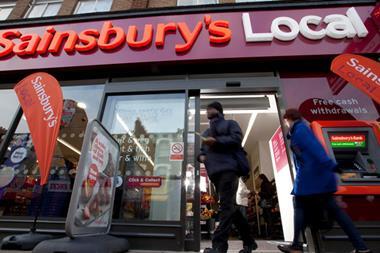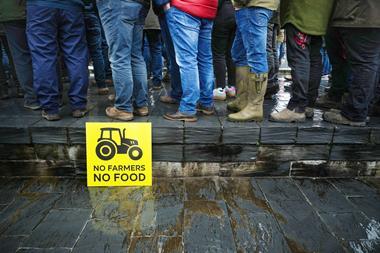Luck is with the UK’s top grocer in the lottery for Safeway stores, says Siân Harrington
The one thing missing from Tesco’s triumphant results announcement this week was any news of Safeway store acquisitions. Considering the UK’s number one food retailer is in pole position to pick up stores from Morrisons, thanks in the most part to Competition Commission constraints on who can buy what, such news cannot be far off. But which stores would be the best fit to the Tesco business? And will the giant be able to purchase those that are likely to deliver the best returns?
Research for The Grocer shows that Tesco is indeed likely to be the winner of the big three supermarkets, assuming Morrisons is happy to sell to such a major rival. It is eligible to bid for four of the eight stores whose catchments match best with its customer profile. It is also front-runner for seven other stores with which it has the second best fit.
Asda, on the other hand, has received a double blow. Having been prohibited from bidding for Morrisons in the first place it is now unable to buy those stores that fit best with its customer profile. In fact, while Asda has the best demographic fit to 16 stores it is likely to end up with just three.
CACI examined the demographic profile of people in the catchments of 30 of the remaining 38 Safeway stores that need to be divested by Morrisons under the terms of its purchase of Safeway (see right).
The list contains only stores that are definitely for sale and assumes the Safeway fascia store is to be sold rather than Morrisons, although there will be little difference in the catchments.
Each of the big three is likely to pick up stores that do not fit well to its customer profiles while being ineligible to buy those that are a perfect fit. Burton-on-Trent, for example, has the best demographic fit to Tesco but Asda is more likely to purchase the store because both Tesco and Sainsbury are forbidden. Likewise Asda has a poor demographic fit to Shrewsbury but may well purchase the store because the top fit, Sainsbury, is unable to bid.
A quarter of the catchment of Newton-Le-Willows, Sedgley, Swinnow Road and Team Valley and 35% of St Helen’s is struggling families. This is Asda’s heartland, at 22% of its customer profile compared to 14% for Tesco and 10% for Sainsbury. Yet Asda is unable to bid for any of these stores.
In fact, it is only eligible to bid for one store with which it has the best demographic fit, and that is Coventry.
According to CACI, Tesco will end up with the bulk of stores, taking 12 of the 30 analysed in the study.
“Despite only having the best demographic fit to nine of the stores, in many cases Tesco is still likely to secure a store as the most obvious purchaser is ruled out on competitive grounds,” says CACI analyst Paul Langston. Tesco is entitled to bid for 17 of the 30 stores.
At the end of last month Waitrose picked up 14 stores from the full disposal list, plus four other Safeways and a Morrisons.
CACI predicts eight of the remaining 30 stores analysed will end up going to other retailers outside the top three. In three cases
The one thing missing from Tesco’s triumphant results announcement this week was any news of Safeway store acquisitions. Considering the UK’s number one food retailer is in pole position to pick up stores from Morrisons, thanks in the most part to Competition Commission constraints on who can buy what, such news cannot be far off. But which stores would be the best fit to the Tesco business? And will the giant be able to purchase those that are likely to deliver the best returns?
Research for The Grocer shows that Tesco is indeed likely to be the winner of the big three supermarkets, assuming Morrisons is happy to sell to such a major rival. It is eligible to bid for four of the eight stores whose catchments match best with its customer profile. It is also front-runner for seven other stores with which it has the second best fit.
Asda, on the other hand, has received a double blow. Having been prohibited from bidding for Morrisons in the first place it is now unable to buy those stores that fit best with its customer profile. In fact, while Asda has the best demographic fit to 16 stores it is likely to end up with just three.
CACI examined the demographic profile of people in the catchments of 30 of the remaining 38 Safeway stores that need to be divested by Morrisons under the terms of its purchase of Safeway (see right).
The list contains only stores that are definitely for sale and assumes the Safeway fascia store is to be sold rather than Morrisons, although there will be little difference in the catchments.
Each of the big three is likely to pick up stores that do not fit well to its customer profiles while being ineligible to buy those that are a perfect fit. Burton-on-Trent, for example, has the best demographic fit to Tesco but Asda is more likely to purchase the store because both Tesco and Sainsbury are forbidden. Likewise Asda has a poor demographic fit to Shrewsbury but may well purchase the store because the top fit, Sainsbury, is unable to bid.
A quarter of the catchment of Newton-Le-Willows, Sedgley, Swinnow Road and Team Valley and 35% of St Helen’s is struggling families. This is Asda’s heartland, at 22% of its customer profile compared to 14% for Tesco and 10% for Sainsbury. Yet Asda is unable to bid for any of these stores.
In fact, it is only eligible to bid for one store with which it has the best demographic fit, and that is Coventry.
According to CACI, Tesco will end up with the bulk of stores, taking 12 of the 30 analysed in the study.
“Despite only having the best demographic fit to nine of the stores, in many cases Tesco is still likely to secure a store as the most obvious purchaser is ruled out on competitive grounds,” says CACI analyst Paul Langston. Tesco is entitled to bid for 17 of the 30 stores.
At the end of last month Waitrose picked up 14 stores from the full disposal list, plus four other Safeways and a Morrisons.
CACI predicts eight of the remaining 30 stores analysed will end up going to other retailers outside the top three. In three cases



















No comments yet